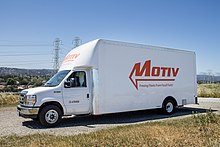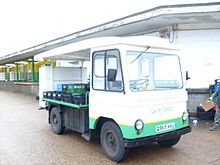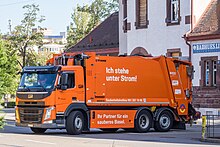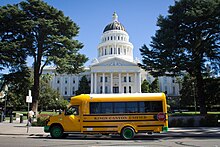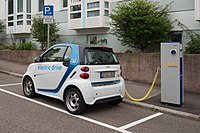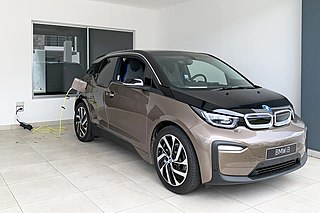
An electric vehicle (EV) is a vehicle that uses one or more electric motors for propulsion. The vehicle can be powered by a collector system, with electricity from extravehicular sources, or can be powered autonomously by a battery or by converting fuel to electricity using a generator or fuel cells. EVs include road and rail vehicles, electric boats and underwater vessels, electric aircraft and electric spacecraft.
The California Air Resources Board is an agency of the government of California that aims to reduce air pollution. Established in 1967 when then-governor Ronald Reagan signed the Mulford-Carrell Act, combining the Bureau of Air Sanitation and the Motor Vehicle Pollution Control Board, CARB is a department within the cabinet-level California Environmental Protection Agency.

The Toyota RAV4 EV is an all-electric version of the popular RAV4 SUV produced by Toyota until 2014. Two generations of the EV model were sold in California, and to fleets elsewhere in the US, with a gap of almost ten years between them.
BYD Auto Co., Ltd. is the automotive subsidiary of BYD Company, a publicly listed Chinese multinational manufacturing company. It manufactures passenger battery electric vehicles (BEVs) and plug-in hybrid electric vehicles (PHEVs), collectively known as new energy vehicles (NEVs) in China. It also produces electric buses and trucks.
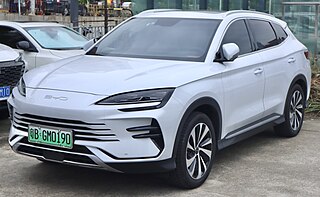
A plug-in hybrid electric vehicle (PHEV) is a type of hybrid electric vehicle equipped with a rechargeable battery pack that can be replenished by connecting a charging cable into an external electric power source, in addition to internally by its on-board internal combustion engine-powered generator. While PHEVs are predominantly passenger cars, there are also plug-in hybrid variants of sports cars, commercial vehicles, vans, utility trucks, buses, trains, motorcycles, mopeds, military vehicles and boats.

An electric bus is a bus that is propelled using electric motors, as opposed to a conventional internal combustion engine. Electric buses can store the needed electrical energy on board, or be fed mains electricity continuously from an external source such as overhead lines. The majority of buses using on-board energy storage are battery electric buses, where the electric motor obtains energy from an onboard battery pack, although examples of other storage modes do exist, such as the gyrobus that uses flywheel energy storage. When electricity is not stored on board, it is supplied by contact with outside power supplies, for example, via a current collector, or with a ground-level power supply, or through inductive charging.

An alternative fuel vehicle is a motor vehicle that runs on alternative fuel rather than traditional petroleum fuels. The term also refers to any technology powering an engine that does not solely involve petroleum. Because of a combination of factors, such as environmental and health concerns including climate change and air pollution, high oil-prices and the potential for peak oil, development of cleaner alternative fuels and advanced power systems for vehicles has become a high priority for many governments and vehicle manufacturers around the world.

A battery electric bus is an electric bus that is driven by an electric motor and obtains energy from on-board batteries. Many trolleybuses use batteries as an auxiliary or emergency power source.

A charging station, also known as a charge point, chargepoint, or electric vehicle supply equipment (EVSE), is a power supply device that supplies electrical power for recharging plug-in electric vehicles.

An electric car or electric vehicle (EV) is a passenger automobile that is propelled by an electric traction motor, using only energy stored in on-board batteries. Compared to conventional internal combustion engine (ICE) vehicles, electric cars are quieter, more responsive, have superior energy conversion efficiency and no exhaust emissions and lower overall vehicle emissions. The term "electric car" normally refers to plug-in electric vehicle, typically a battery electric vehicle (BEV), but broadly may also include plug-in hybrid electric vehicle (PHEV), range-extended electric vehicle (REEV) and fuel cell electric vehicle (FCEV).

A battery electric vehicle (BEV), pure electric vehicle, only-electric vehicle, fully electric vehicle or all-electric vehicle is a type of electric vehicle (EV) that exclusively uses chemical energy stored in rechargeable battery packs, with no secondary source of propulsion. BEVs use electric motors and motor controllers instead of internal combustion engines (ICEs) for propulsion. They derive all power from battery packs and thus have no internal combustion engine, fuel cell, or fuel tank. BEVs include – but are not limited to – motorcycles, bicycles, scooters, skateboards, railcars, watercraft, forklifts, buses, trucks, and cars.

The BYD F3DM (Dual-mode) is a plug-in hybrid compact sedan manufactured by BYD with an all-electric range of 60 kilometres (37 mi) and a hybrid electric powertrain that can extend the range an additional 480 kilometres (300 mi). The F3DM is the world's first mass-produced plug-in hybrid automobile and went on sale to government agencies and corporations in China on December 15, 2008. During its first year in the market the F3DM plug-in sold only 48 vehicles. Sales to the general public began in Shenzhen in March 2010, and 417 units were sold during 2010. Cumulative sales in China reached 3,284 units through October 2013, when sales ended, and only 11 units were sold in Europe through October 2012.

The BYD e6 is a battery electric vehicle manufactured by BYD Auto from 2009. Field testing for the first generation model began in China in May 2010 with 40 units operating as taxis in the city of Shenzhen. Sales to the general public began in Shenzhen in October 2011, over two years behind schedule of the originally planned release date of 2009.
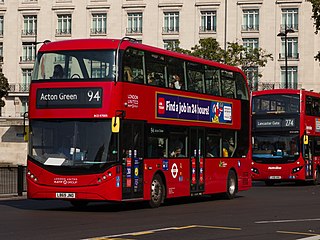
There are 3,835 hybrid buses, 950 battery electric buses, and 20 hydrogen fuel cell buses operating in London, as of March 2023, out of a total bus fleet of 8,643 – this is around 56% of the bus fleet.

The BYD K-series bus are a line of battery electric buses manufactured by the Chinese automaker BYD, powered with its self-developed lithium iron phosphate battery, featuring a typical operating range of 250 kilometres (160 mi) per charge under urban road conditions. It is available in several different nominal lengths, from 7.0 to 13.7 m and also as a 18 m (60 ft) (articulated) bus. The rear axle is powered by two electric traction motors; the battery capacity and motor power of each model varies depending on the nominal length and passenger capacity.

Motiv Power Systems is an American manufacturer of all-electric chassis for medium-duty commercial vehicles, based in Foster City, California.
GreenPower Motor Company Inc. is a Canadian electric bus manufacturer and distributor in North America. The company fabricates multiple zero-emission models, including transit buses, school buses, and double decker buses. GreenPower headquarters are in Vancouver, British Columbia, with a sales office in Rancho Cucamonga, California; an assembly facility in Porterville, California; and a production facility in South Charleston, West Virginia. Its stock is traded on Nasdaq the United States.
Electric vehicle policies in Australia include incentives such as electric vehicle subsidies, interest-free loans, registration exemptions, stamp duty exemptions, the luxury car tax exemption and discounted parking for both private and commercial purchases. The adoption of plug-in electric vehicles in Australia is driven mostly by state-based electric vehicle targets and monetary incentives to support the adoption and deployment of low- or zero-emission vehicles.



